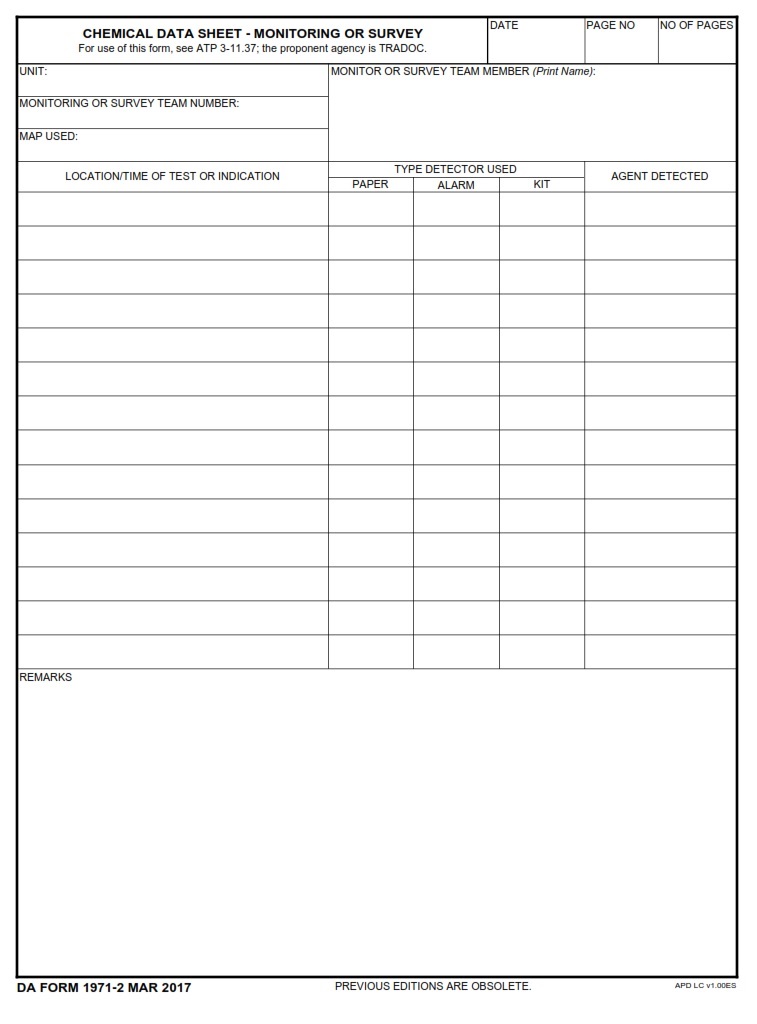Table of Contents
FREE-ONLINE-FORMS.COM – DA Form 1971-2 – Chemical Data Sheet – Monitoring Or Survey – Are you curious about the invisible threats that surround us every day? From the air we breathe to the water we drink, chemicals are an ever-present force in our environment. In order to protect ourselves and ensure our safety, it is crucial to have effective monitoring systems in place. That’s where the DA Form 1971-2 comes into play – a powerful tool used by professionals to gather critical chemical data. In this article, we will explore the importance of this form and its role in keeping us safe from potential hazards. Get ready for a fascinating journey into the world of chemical monitoring!
Picture this: You’re walking down a bustling city street, surrounded by skyscrapers and people rushing by on their daily routines. Everything seems normal until you catch a glimpse of a group of individuals wearing hazmat suits, meticulously examining various objects with strange-looking devices. What could they be looking for? The answer lies in the DA Form 1971-2 – an indispensable tool used for monitoring and surveying chemicals that may pose risks to our health and wellbeing.
Download DA Form 1971-2 – Chemical Data Sheet – Monitoring Or Survey
| Form Number | DA Form 1971-2 – |
| Form Title | Chemical Data Sheet – Monitoring Or Survey |
| Edition Date | 3/1/2017 |
| File Size | 30 KB |
What is a DA Form 1971-2?
A DA Form 1971-2, also known as a Chemical Data Sheet, is an essential document used for monitoring or surveying various chemical substances and their potential hazards. It serves as a comprehensive record that provides crucial information regarding the identification, properties, handling, storage, and disposal of chemicals.
One of the primary functions of a DA Form 1971-2 is to ensure the safety of personnel working with or around hazardous materials. By accurately recording specific details about each chemical substance, such as its toxicity level and required protective equipment, this form helps prevent accidents and promotes responsible handling practices.
Moreover, this form plays a vital role in emergency response situations. In the event of a chemical spill or release, having readily available data on hand is crucial for first responders to assess risks and plan mitigation strategies effectively. The use of DA Form 1971-2 enables rapid decision-making by providing pertinent details about the location and quantities of hazardous substances involved.
Ultimately, incorporating the use of DA Form 1971-2 into monitoring or surveying processes not only enhances safety protocols but also aids in regulatory compliance. By maintaining accurate records through these forms, organizations can demonstrate their commitment to meeting legal requirements while protecting both their workers and the environment from potential harm caused by mishandling chemicals.
In conclusion, understanding what a DA Form 1971-2 entails is critical for anyone involved in working with hazardous chemicals or overseeing their usage within an organization.
Where Can I Find a DA Form 1971-2?
When it comes to finding a DA Form 1971-2, also known as the Chemical Data Sheet for Monitoring or Survey, there are a few key places you can look. One of the first places to check is your local military base or installation. The supply office or depot should have copies of all required forms and documents, including the DA Form 1971-2. If you’re unable to find it there, another option is to search online government databases. Many government websites offer downloadable versions of military forms like the DA Form 1971-2.
In addition to these options, it may be helpful to reach out to fellow military personnel or veterans who have experience with chemical monitoring or surveys. They may know specific resources or websites where you can obtain a digital copy of the form. Remember that staying up-to-date on any changes or updates to the form is crucial as well since regulations and requirements can vary over time.
In conclusion, if you’re in need of a DA Form 1971-2 for chemical data sheet monitoring or survey purposes, start by checking your local military base’s supply office or depot for physical copies. If that proves unsuccessful, explore online government databases where downloadable versions might be available. Don’t forget about reaching out to knowledgeable individuals within your network who can guide you toward valuable resources and provide insights into any updates regarding this important document.
DA Form 1971-2 – Chemical Data Sheet – Monitoring Or Survey
The DA Form 1971-2, also known as the Chemical Data Sheet – Monitoring or Survey, is a critical tool used by military personnel and emergency response teams to assess chemical hazards in their surroundings. This form allows them to identify and record data such as the type of chemical, concentration levels, and potential health risks associated with exposure. By monitoring or surveying areas for chemical substances, professionals can take proactive measures to mitigate risks and ensure the safety of themselves and others.
One significant aspect of using the DA Form 1971-2 is that it promotes accurate documentation of chemical data. This form serves as a standardized template for recording essential information about hazardous materials present in a specific location. It includes details such as physical properties, toxicity levels, disposal requirements, and necessary protective equipment. With this detailed monitoring system in place, military personnel and emergency responders can better assess the risks associated with different chemicals and develop appropriate strategies to prevent harm.
Moreover, the utilization of DA Form 1971-2 emphasizes preparedness during potential incidents involving chemical hazards. Through regular monitoring or surveys conducted using this form, organizations can gather valuable data over time that helps create comprehensive profiles of various sites or areas under their jurisdiction. As a result, they can better anticipate possible dangers based on past findings while remaining vigilant for new threats that may arise.
